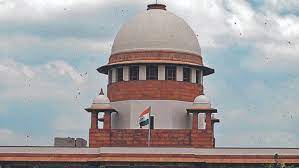The issue that falls for consideration in this case revolves around the true construction, meaning and import of the expression ‘vacant land’ contained in Section 2(q) of the Urban Land (Ceiling and Regulation) Act, 1976 (in short, the ‘Ceiling Act’), especially with reference to sub-clause (i) thereof. (Para 1)
Section 3 provides that ‘on and from the commencement of this Act’, no person shall be entitled to hold any ‘vacant land’ in excess of the ceiling limit in the territories to which the Act applies under Section 1(2) thereof. Section 4 provides distinct ceiling limits for different urban agglomerations falling within categories A to D in Schedule I. Section 6 of the Ceiling Act obligates the person holding ‘vacant land’ in excess of ceiling limit to file statement whereupon the Competent Authority would prepare a draft statement under Section 8 of the Act and after considering any objection received against it, Section 9 contemplates a final statement determining the vacant land held by the person concerned. Such ‘vacant land’ shall then be notified under Section 10 of the Act and would be acquired by the State Government (Para 3)
The State Government, thereafter, issued a notice under Section 10(5) of the Ceiling Act on 4th March, 1980 asking the appellants to deliver possession of the ‘vacant land’. (Para 10)
It is broadly an admitted fact that the appellants in their statement under Section 6(1) of the Ceiling Act declared the entire piece of land measuring 3429 sq.m. as ‘vacant land’. They, however, in their objection against the draft statement claimed existence of a structure, the area of which was liable to be excluded from ‘vacant land’ in view of Section 2(q)(ii) of the Ceiling Act. Such an objection did not find favour with the Competent Authority, which after excluding retainable area measuring 500 sq.m. as per Section 4(1)(a), declared the remaining land measuring 2929 sq.m. as ‘vacant land’. (Para 13)
As of now, we need not consider the question whether there existed any `building’ within the meaning of sub-clause (ii) of Section 2(q) of the Ceiling Act on the subject land which could qualify for exclusion from the permeates of a ‘vacant land’. This is largely a question of fact and will be determined at the time of final hearing. (Para 14)
We are thus of the considered opinion that the interpretation, spirit and object of the Ceiling Act, as it was envisaged at the time of its enactment, when juxtaposed against the regressive impact experienced in different States which is indicated in the Statement of Objects and Reasons of the Repeal Act, invite an authoritative determination of all the related issues by a Larger Bench. This case may, therefore, be placed before Hon’ble the Chief Justice of India for appropriate directions. (Para 37)
SUPREME COURT OF INDIA
2023 STPL(Web) 323 SC
[2023 INSC 884]
M/S. Kewal Court Pvt. Ltd. And Anr. Vs. State Of West Bengal And Ors.
Civil Appeal No. 6257 of 2014-Decided on 9-10-2023
https://stpllaw.in/wp-content/uploads/2023/10/2023-STPLWeb-323-SC.pdf








